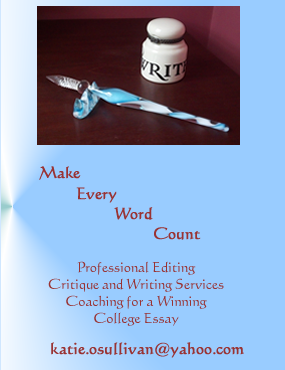CapeWomenOnline - Where Cape Women Shine
Your local venue for the women of Cape Cod to share their ideas, experiences and resources while inspiring each other in their life's journey
Inspire . Encourage . Network . Share
In her column The Write Way, Katie O'Sullivan discusses common editing errors that can send your writing directly into the slush pile.
If you have a question about writing or editing we'd love to hear it!
Please email your questions to Katie@CapeWomenOnline.com
The Write Way: A Plethora of Homos
Homonyms vs. Homophones vs. Homographs
by Katie O’Sullivan
I still have vivid memories from elementary school, where they tried to make learning the intricacies of the English language a “fun” experience.
There were usually crayons involved. And sometimes math. Like when you draw pictures of “butter” on the left and “fly” on the right with a big plus sign in between them? What does it equal?
Butterfly! Ah, the beauty of compound words. Or, the beauty of a stick of butter that suddenly sprouts colorful wings, depending on the student’s sense of humor.
By fourth grade, the teachers tried to explain about homonyms, homophones, and homographs. Also with drawings, trying to show how words that sound alike can mean different things. Sometimes these words are spelled the same way, sometimes they’re spelled differently.
(No wonder English is such a tricky language to learn!)
So what’s the difference between all these homo words? And why should you care, now that you’re out of grammar school? (Hmmm, and why do they call it “grammar” school?)
Keep in mind, the Latin root “Homo” means “Same.” It’s what these terms have in common – they’re talking about words that have something that’s the same. They are confusing terms because they also mean something is different – meanings, spellings, and even pronunciation.
1. Homonyms are words that sound the same, are spelled the same but mean different things.
Think of it as a sort of math equation: Homo = same + nym = word.
Examples:
Bear arms; but don’t arm a bear.
Spring into action in Spring, my favorite season.
2. Homophones are words that sound the same but have different spellings and meanings.
Think of it this way: Homo = same + phone = sound
Examples:
A bear without fur would be bare.
The plumber ducked under the pipe to grab his duct tape.
3. Homographs are different. And tricky, especially for non-native English speakers. These are words that are spelled the same way but are pronounced differently and have different meanings.
Again, with the math equation: Homo = same + graph = write
Say the following examples out loud, and see what I mean. The words look the same on the page, but when you know the meaning, you know they are pronounced differently.
Examples:
Tear a paper –or- cry tears of joy (the first “ea” is pronounced like “a” the second sounds like “e”)
Lead a parade –or- a ton of lead weight (the first is pronounced “leed” the second “led”)
But it’s not just the “ea” vowels that can be tricky. Sometimes a single vowel can change sound, too… like in “bass.” (Bass guitar, bass fisherman) It’s a homograph. Same spelling, different word entirely.
Cool trivia facts, Ms. Editor. But why do I care?
Well, Dear Reader, you should pay attention because homophone misuse accounts for MOST OF THE COMMON WRITING MISTAKES OUT THERE. Using a word that sounds like the one you’re looking for… but means something else entirely. This all-too-common mistake plagues every type of writing, from novels to text books to student essays to that report you were supposed to have on the boss’s desk ten minutes ago.
(If I had a quarter for every time I’ve seen affect/effect misused, I’d be a millionaire!)
The computer won’t catch these mistakes. Spell check is useless in the case of homophones, homonyms, or homographs (although, remember, only homophones are actually spelled differently anyway! So with the other two, you’re good to go with just a spell check!)
If you’re unclear about which word you mean to use, look it up. And don’t think your editor is mean when she corrects you.

FROM THE MAILBAG:
A reader wrote to ask, “How does one know when to use into or in to?”
This really boils down to parts of speech – not the sexiest of subjects when taught in middle school, when your thoughts were more likely on that cute boy sitting two rows over from you. But prepositions and adverbs have their time and place, and this is one of those times.
“Into” is a preposition, and indicates movement toward the inside of somewhere or something.
Example:
The kids jumped into the pool with a splash.
In to is the adverb in followed by the preposition to. An adverb modifies a verb. The preposition is the start of a separate clause.
The difference seems subtle, but read the following example, and think how they would be changed if “in to” were replaced by “into.”
Example:
Sam turned his paper in to the teacher.
He turned his paper in. That’s a complete thought right there, even without the prepositional phrase.
For Sam to turn his paper “into” the teacher, he’d have to be a wizard. He could turn it into origami or a crumpled ball, but not a teacher.

Katie O'Sullivan loves editing, writing and playing with words. She lives in Harwich with her family, and the big dogs who “make” her walk on the beach every day.
Her third book, the young adult novel SON OF A MERMAID, will be available May 2013 from Crescent Moon Press. Check the Event listings for upcoming book signings, or visit her blog for details.
For more information about working with Katie to make your words sparkle on the page, email her at: katie.osullivan@yahoo.com




